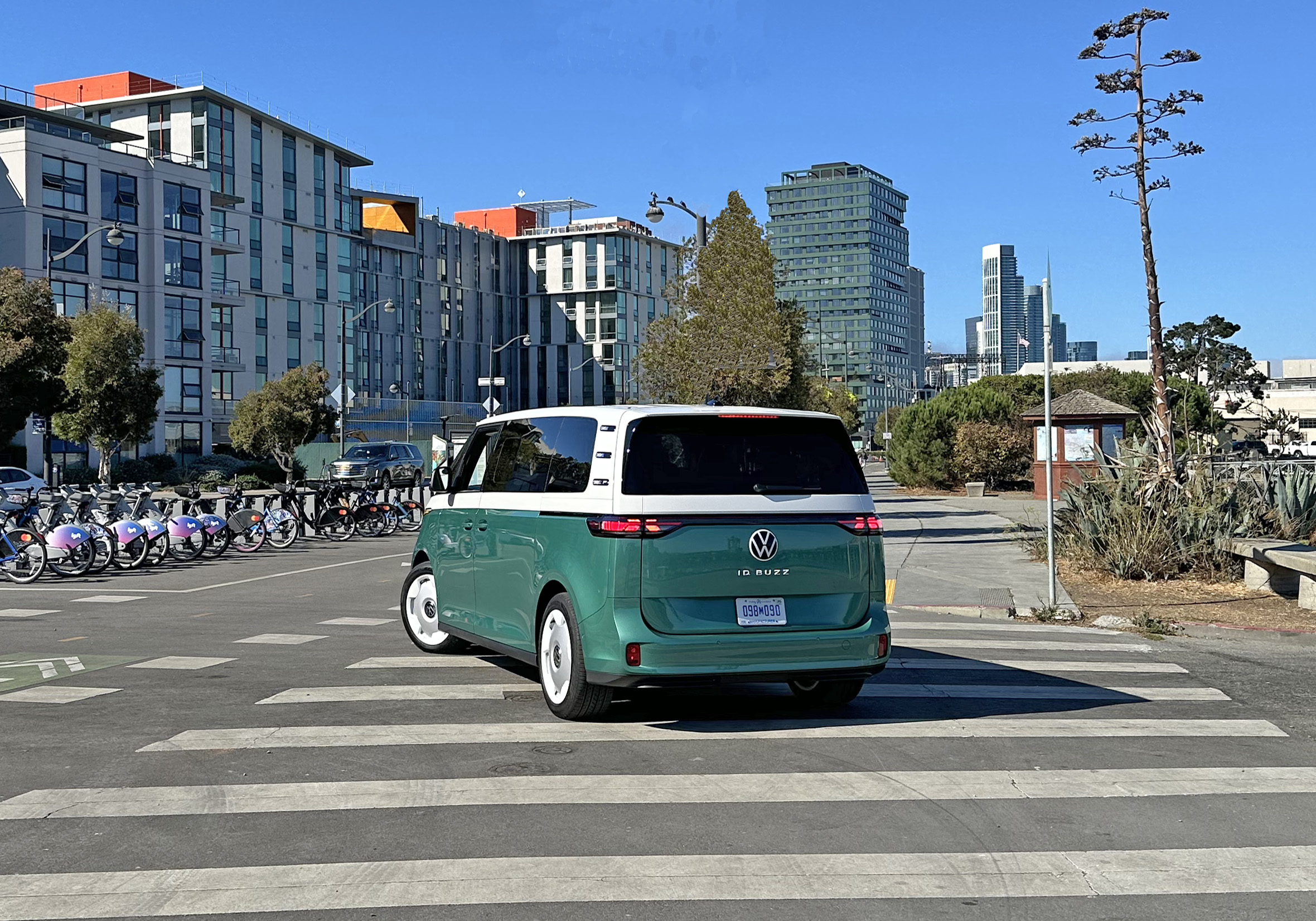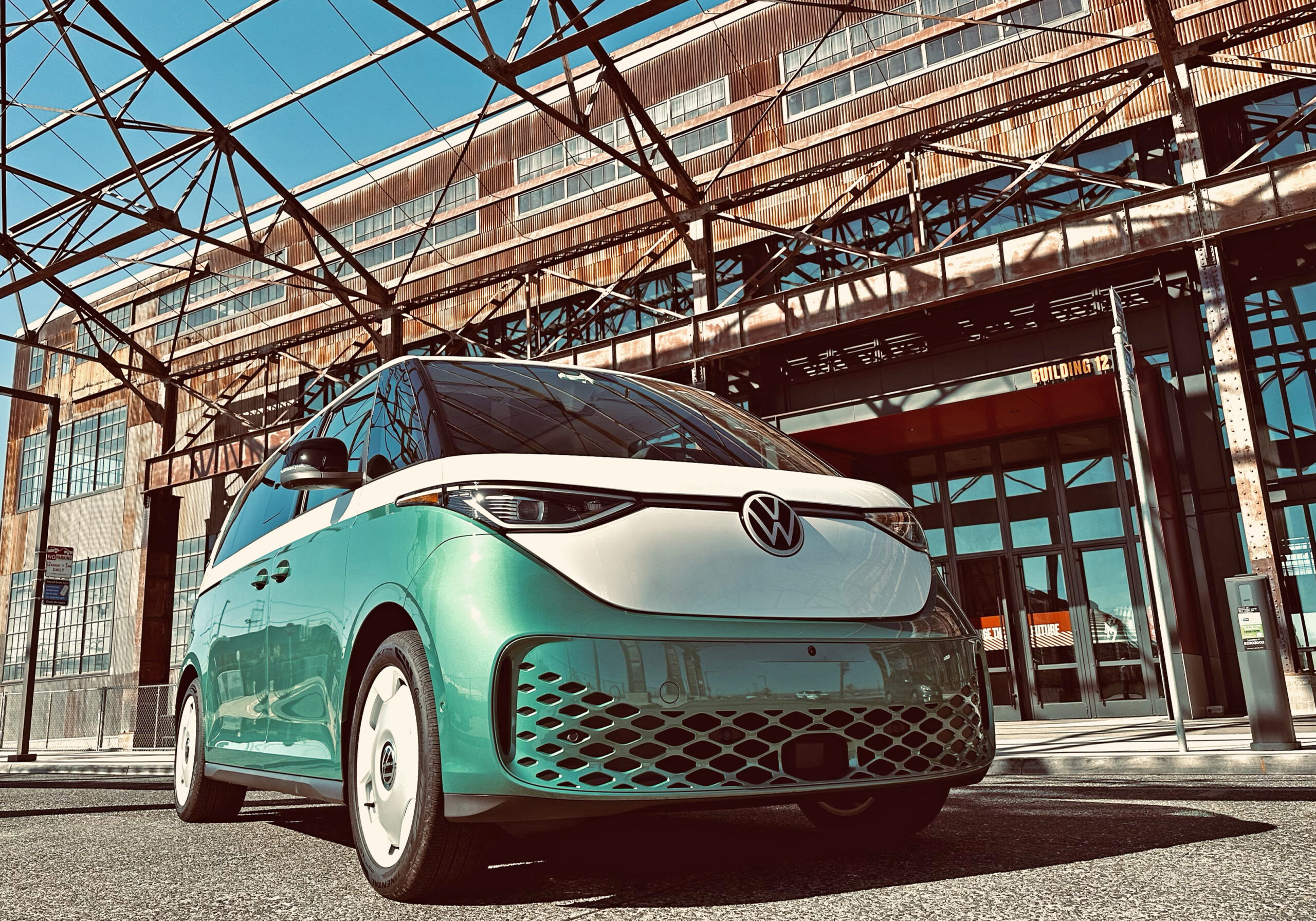
The VW Microbus’ reincarnation for the electric age, Volkswagen’s three-row 2025 ID.Buzz, is a roomier, more powerful, and far-more feature laden update of the original. While not as quirkily cute, its modern styling with lots of nods to the past is likely to hit the right note with many shoppers.
It’s not a vehicle you’ll be likely to lose in a parking lot – unless a lot of the neighbors buy their own. If you don’t like being stared at, the new Buzz may not be for you until there are enough sold that the novelty of this re-imagined bus wears off.
Getting down to business, we can tell you that the ID.Buzz is a roomy and thoroughly modern three-row, seven-seat minivan, although VW insists that it isn’t really a minivan, at least not like a Honda Odyssey. Its exterior lines evoke those of its ancestor, but inside it offers more room, more creature comforts and infinitely more technology.
With a base price of $61,545, it’s a safe bet that this VW bus won’t be the top pick of starving students seeking cheap wheels to haul their friend to parties and their belongings from apartment to apartment. But it is likely to appeal to craftsmen, surfers and campers of a certain income level, and families seeking max room in a package that sets them apart.
We also wouldn’t be a bit surprised to see some decked out in corporate logo and serving as the CEO’s new limo-cum-office-on-wheels, either.
VW says the three-row 2025 ID.Buzz doesn’t have any direct competitors in North America, and we’ll agree with that. Certainly, there’s nothing out there that looks the same or, in the same size class, offers as much interior space.
But there are alternatives for those who want lots of room but also want to keep their carbon footprint as low as possible.
The Chrysler Pacifica Hybrid, which actually is a plug-in hybrid, is the only other plug-in electrified minivan; the rest are gas-only, with Toyota’s Sienna available only as a conventional hybrid and Kia’s Carnival offering a hybrid powertrain option. There also are several large all-electric crossovers and SUVs with three rows of seating, including the Cadillac Escalade IQ, Kia EV9, Mercedes-Benz EQS SUV, Rivian R1S, Tesla Model X, and Volvo EX90, The Audi Q8 e-tron and BMW iX could be in the mix for some, but they only offer two rows of seating.
None of the potential rivals offer as much interior space as the ID.Buzz, though, and while the Buzz isn’t cheap, all but the regular minivans cost more.
In the US and Canada, VW is marketing the three-row Buzz; Europe’s had a short wheelbase, two-row model since late 2022. The North American version is really just the upper North American version, though, as there are no plans yet to sell it in Mexico.
The 2025 ID.Buzz shares the same dedicated EV platform Volkswagen uses for other members of the all-electric ID family. In the U.S., we have the ID.4 crossover and the upcoming ID.7 sport sedan.
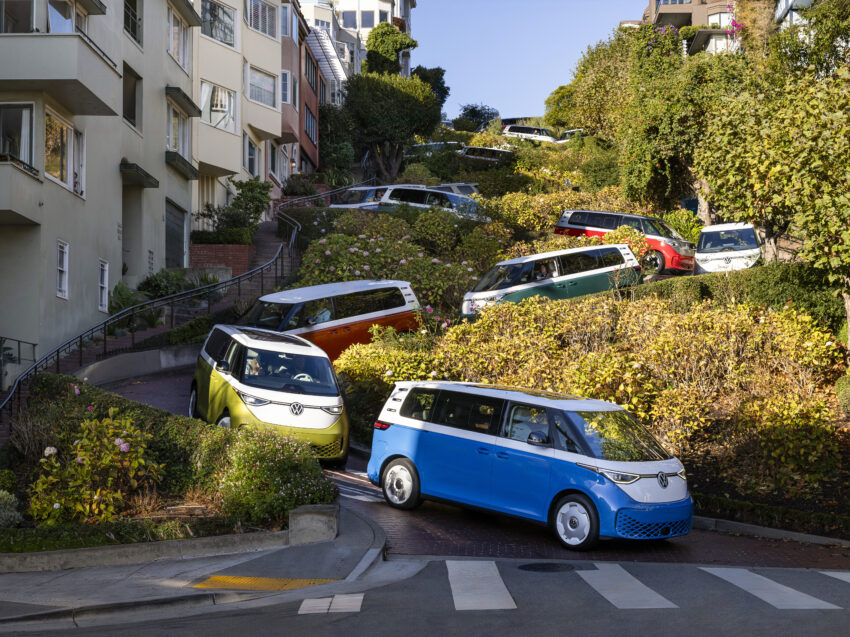

Our Verdict
If it is in your price range, you’ll be doing yourself a disservice if you go minivan or SUV (non off-roading) shopping without putting the 2025 ID.Buzz on your list of models to look at.
ID. Buzz Trims and Pricing
The 2025 ID.Buzz is available in three trims, Pro S, Pro S Plus and a launch-only 1st Edition. All will have standard real-wheel drive and the two top trims will be available with a more powerful electronic all-wheel drive system for a $4,500 premium. VW says there are no plans – at least not yet – for adding a lower-priced version with a smaller battery and less range to the mix.
Pro S: The base trim starts at $61,445, including a $1,550 destination charge. Standard equipment includes a second-row bench seat and a pair of rear seats for a total of seven seating positions, 20-inch alloy wheels, LED lighting all around, an oversize, lighted VW badge on the nose, three monotone exterior colors and two interior color schemes, power-sliding side doors and side windows, heated power-folding side mirrors with memory, power front-door windows, a power tailgate, imitation-leather upholstery with a choice of three interior color combinations, heated and cooled power-adjustable front seats with a massage function, heated outboard seats in the second row, fold-flat second- and third-row seat seatbacks, a removable center console, tri–zone climate system with dedicated vents for each seating row, 30-color ambient interior lighting, a 5.3-inch digital driver’s information display, and a 12.9-inch infotainment center touchscreen.
Pro S Plus: The Pro S Plus starts at $65,045 ($69,545 with all-wheel drive) and builds on the base trim with a 14-speaker Harman/Kardon sound system, an easy-open and close feature for the power sliding side doors and tailgate, a third interior color scheme choice, a color head-up display, a manually-retractable tow hitch, and a surround-view camera function for enhanced viewing of the area around the vehicle. The all-wheel drive version also gets a heated windshield and a pair of captain’s chairs instead of bench seating in the second row – reducing total seating capacity to six.
Optional equipment for the Pro S Plus includes a large electronically dimmed glass sunroof ($1.495), eight two-tone exterior paint choices ($995 each), and a “Flexboard” with dual storage bins that create a raised flat cargo floor when the third-row seat backs are folded down. Second-row captain’s chairs are an option for the rear-drive Pro S Plus.
1st Edition: This only-for-2025 trim starts at $67,045 ($71,545 with all-wheel drive). It starts with the same standard features as the base Pro S – but only one interior color scheme – and adds trim-exclusive wheels and exterior badging, a choice of five two-tone exteriors, roof rail cross bars, an electronically dimmable glass roof, surround-view camera, Harman/Kardon sound system and the Flexboard cargo system. Captain’s chairs for the second row are standard with all-wheel drive but not available for the rear-drive version.
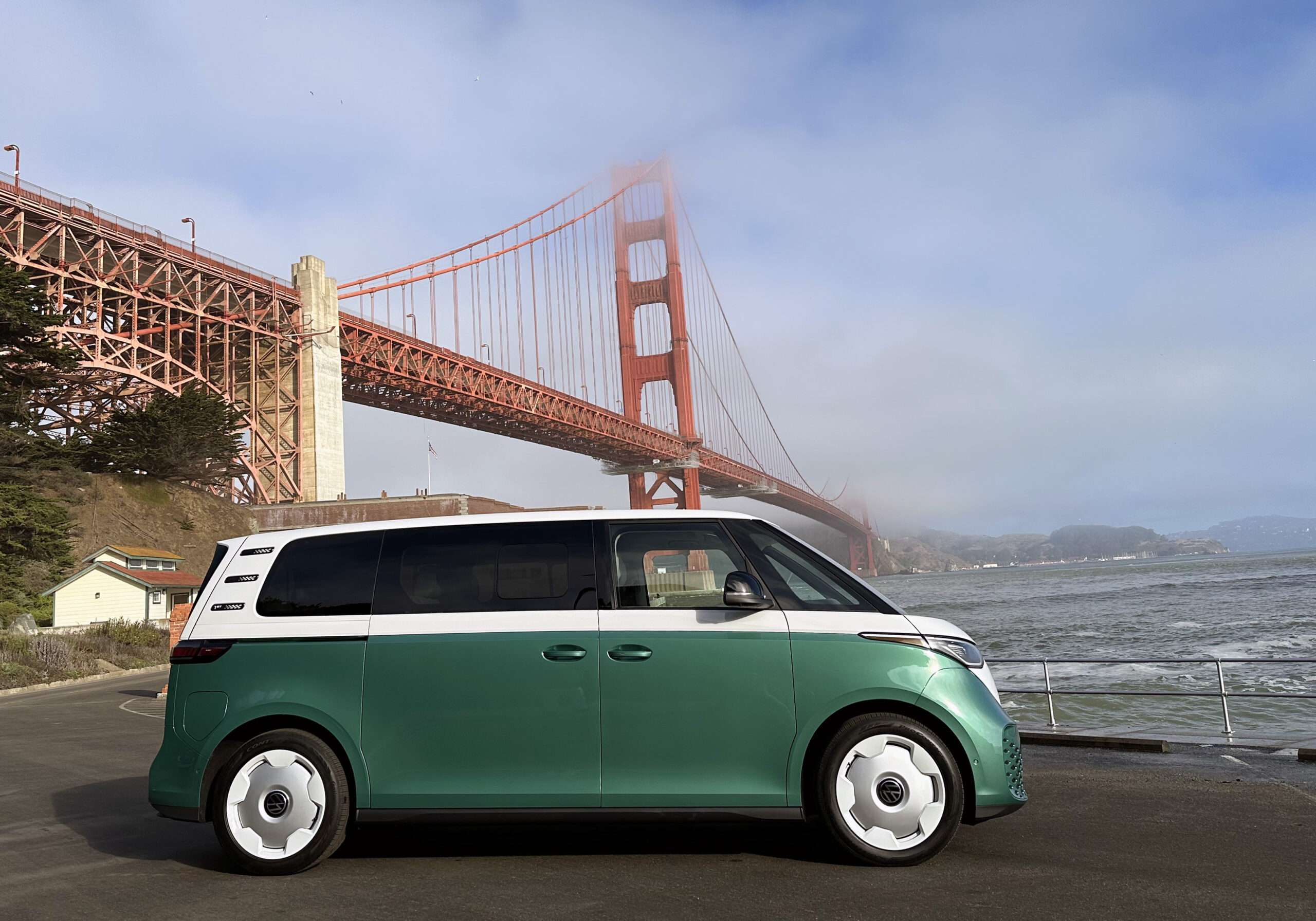
What Motivates the ID.Buzz?
The 2025 ID.Buzz’s 91-kWh battery has 86 kWh of usable energy and is used in powers both the single-motor, rear-wheel-drive and dual—motor, all-wheel drive variants.
The single-motor system is rated at 282 horsepower and 406 pound-feet of torque; the dual-motor, system adds a 107-hp electric motor for the front axle for combined maximum output of 335 hp.
The all-wheel drive system is fully electronic – there’s no mechanical connection between the front and rear wheels. It’s biased toward rear-drive, with the front motor kicking in as necessary to improve traction.
Among potential rivals, the Chrysler Pacifica Hybrid is rated at 260 hp and is the only potential alternative with less power than the ID.Buzz.
Still, VW says AWD versions can hit 60 from a standing start in just over 6 seconds, which isn’t bad for a three-ton (actually, three tons plus 197 pounds) minivan. Rear-drive versions, with less horsepower and 229 pounds less weight, can do it in around 7.5 seconds. There are quicker three-row competitors – the Rivian R1S can do it in as little as 3 seconds. And there are slower – the Pacifica Hybrid, with front-wheel drive, needs 7.8 seconds.
But the Buzz is a veritable speedster compared to the original Microbus, which had a 30-hp rear-mounted gasoline engine (later upgraded to 55 hp) and took more than half a minute to hit 60 mph from a standing start
Performance
We recently were among the first North American automotive journalists invited to drive the U.S. version and found that it live up to VW’s promises.
We drove a 1st Edition with rear drive across the Golden Gate bridge, along the northern California coastline and through the Marin hills and then by freeway through Oakland and across the Oakland Bay Bridge into downtown San Francisco, experiencing a nice mix of hills and country roads, high-speed highway and congested city traffic.
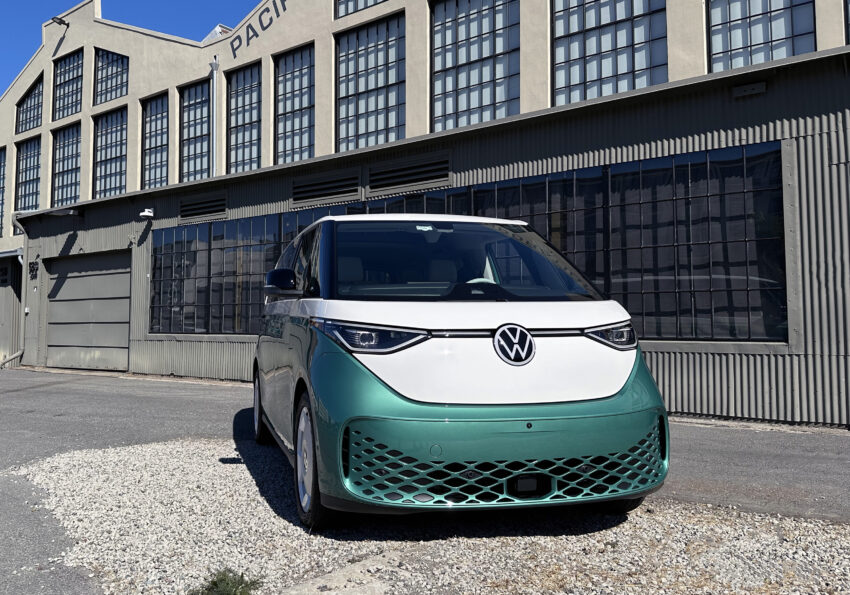
We got off to a slow start – VW wanted to recreate with the modern Buzz a 2010 photograph of a serpentine of VW buses winding down San Francisco’s Lombard Street (see above). But once on the road we found the 2025 ID.Buzz to be quite peppy and very sure-footed. It handled tight curves at higher-than legal speeds with scant body roll and nary a squeak or squeal from the all-season tires. In town, it was remarkably easy to drive. The suspension did a nice job of smoothing out the ride on rougher roads and kept it comfortable on the highway as well.
VW claims the Buzz drives smaller than it is and we found that to be the case. At low speeds it feels a bit heavy – even the lighter rear-drive variants tip the scales at an elephantine 5,968 pounds while the AWD versions weigh in at just over three tons. But it is not unmanageable weight. The low-slung battery pack accounts for 1,230 pounds and helps give the Buzz a low center of gravity, while electronic rack-and-pinion steering and a relatively tight 37-foot turning circle make it fairly easy to toss around. Among likely competitors, only the Mercedes-Benz EQS SUV can execute tighter turns.
We also found the Buzz’s cabin to be very quiet – try that in a vintage bus! There was some wind and road noise, of course – there almost always is, no matter the vehicle – but noting obtrusive. Even with the audio system muted the ambient sound was a murmur, not a roar.
There are a trio of preset driving modes for the Buzz: Eco for maximum range and minimum fun, Comfort for everyday driving, and Sport for slightly quickened steering and accelerator response. There’s also a Custom setting that allows drivers to mix their own mode.
The suspension is set up to handle a fairly hefty load and does an admirable job of it, although it can’t completely smooth out the road’s bigger bumps and dips. Braking is smooth and while VW eschewed a one-pedal setting for the Buzz – boo! – flicking the column-mounted shifter stalk from D to B (for braking) sets up a moderately powerful regenerative braking level that works a lot like downshifting when you lift your accelerator foot going into a curve, That “B” setting can also help improve range by generating juice for the battery when you’re off the accelerator. It works best in stop-and-go city traffic conditions.
Range and Charging Time
The single-motor, rear-drive ID.Buzz is EPA rated at up to 234 miles of range per charge and the more powerful, dual-motor, all-wheel drive variant is very close at 231 miles. There’s little difference in range because the Buzz’s rectangular shape isn’t very aerodynamic.
Among likely rivals, the Rivian R1S is rated between 260 and 316 miles, depending on how it is equipped, and the Mercedes-Benz EQS SUV and Audi Q8 e-tron both are rated at 285 miles. The Kia EV9 can deliver up to 304 miles in rear-drive configuration and 280 miles all-wheel drive. The Tesla Model X leads the pack at 335 miles, while the front-wheel-drive-only Chrysler Pacifica Hybrid can deliver up to 32 miles of all-electric range and, with a full 16.5-gallon tank of gas, a total of 520 miles.
The Buzz uses the same battery and charging architecture as the upcoming Volkswagen ID.7, with a DC fast-charge rate of up to 200 kilowatts an hour, good for a replenishment from 10% to 80% of capacity in about 25 minutes. That’s a little quicker than most prospective alternatives, although the Model X and EV9 can beat it by a few minutes.
[Learn all about EV charging.]
For home charging, VW has equipped the 2025 ID.Buzz with an 11-kilowatt Level 2 (240-volt) system that’s good enough with a properly sized home charger to replenish a fully depleted battery overnight.
Efficiency
The Buzz gets an EPA rating of 88 miles per gallon-equivalent with rear-drive and 80 MPG-e with all-wheel drive, versus 89 MPG-e for the Kia EV9 and leads the pack at 100 MPG-e for the segment-leading Tesla Model X.
We prefer rating EV efficiency by looking at energy consumption on a kilowatt-hours per 10 miles basis. Using that metric, the 2025 ID. Buzz’s scores 42 kWh/100 miles for all-wheel drive and 41 kWh/100 miles with rear drive. That trails the Model X, EV9 and Rivian R1S, ties with the Chrysler Pacifica Hybrid and beats the rest of the pack. So, the Buzz is firmly in the middle of its competitive set for efficiency.
Interior
The 2025 ID.Buzz wows. One could complain that there’s too much hard plastic (the lower door and side panels, center console, and steering column casing), but all the other goodies make that easy to overlook.
The seats may be clad in faux leather, but it is nicely stitched, padded, and perforated to look like the real thing. The front buckets have armrests (like captain’s chairs), seats in the second- and third-rows each can slide forward and backward almost 8 inches, for a wide range of adjustability, and the 50/50-split third-row seats can be individually removed with the tug of a strap. They weigh approximately 35 pounds each, but easily slide out through the tailgate.
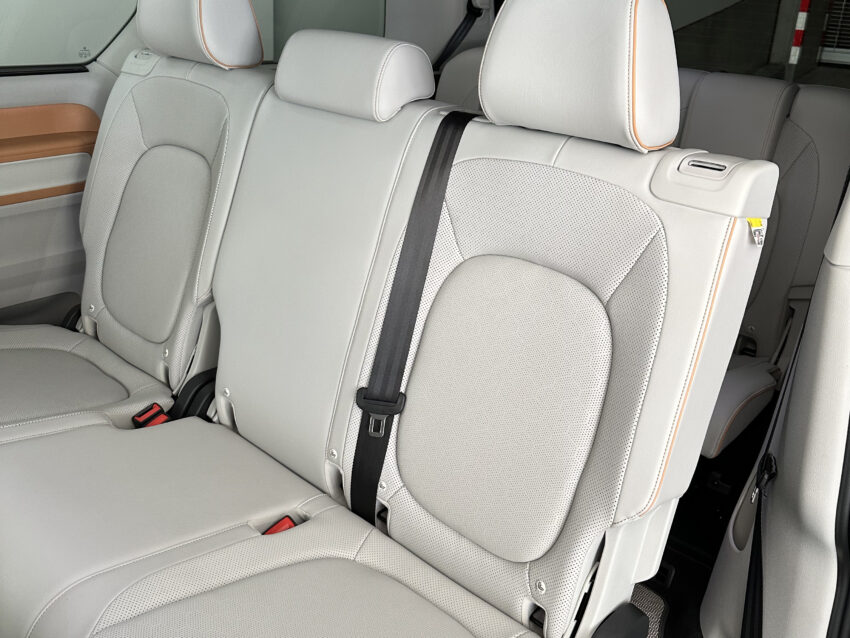
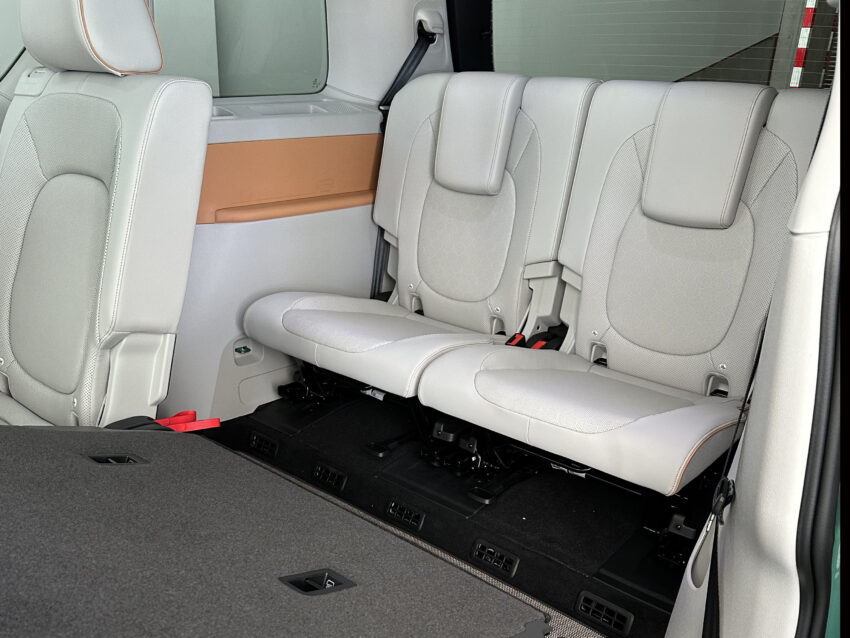
Upper door panels and the rear sidewall for the third row are well-padded, and there are enough storage cubbies, cupholders, and water bottle wells for all passengers. The narrow center console is removable and can be relocated to the second row. Though not particularly spacious, it and has an upper deck with compartment dividers that snap out for double duty: one’s a bottle opener, the other an ice scraper.
The split-level padded dash is trimmed in a wood-look applique and houses a locking glove box with a generously sized open bin just above it. There’s a vertical bin for keys and oher small items on the left of the steering wheel and another, with a wireless phone charger, just to the right. A center-mounted, horizontally oriented 12.9-inch infotainment touchscreen dominates the dash and the driver gets a smaller digital info screen mounted in a stand-alone binnacle on the steering column just behind the wheel.
At 16 feet from bumper to bumper, the three-row ID.Buzz is shorter than any likely alternative in the US market — by as little as 1.1 inch versus the two-row Audi Q8 e-tron and as much as 9.8 inches versus the hulking Mercedes-Benz EQS SUV.
But its 127.5-inch wheelbase is a full foot longer than the Audi’s and 1.1 inches more than the Mercedes’. The 2025 ID.Buzz’s flat floor, high ceiling and wheels-to-the-corners layout open up the interior in a way no competitor can match. It is incredibly roomy – the third-row seats have enough leg and headroom for a pair of NBA forwards – and there’s more passenger and cargo space than any of the likeliest rivals.
The second-row bench seat slides forward with a tug on a side-mounted lever to create a spacious pathway to the third row. Second-row captain’s chairs slide fore and aft but don’t swivel and aren’t removable.
The only flaws (besides hard plastic) are the absence of an overhead strap or handle for passengers to grab as they climb in or out of the back, and the lack of a wide-enough flat exterior sill for shorter drivers and passengers to use to help step into the Buzz’s rather high floored cabin.
The GreenCarGuy is 6’-1” and had to stretch a bit to make the step-up. The sills below the front doors are slanted downward at a sharp angle and can’t be used to stand on, while those beneath the sliding side doors, while flat, are too narrow to afford much of a foothold.
Cargo and Towing with the ID.Buzz
The Buzz is unmatched among three-row SUVs and minivans for cargo capacity. While the area behind the third-row seats isn’t world-class, at 18.6 cubic feet it is easily large enough for a pair of full-size suitcases and a couple of carry-ons. Folding the third-row seat opens up an additional 59 cubic feet for a total of 77.6 cubes, and with the second row-seat backs folded down as well there’s a cavernous 145.5 cubic feet of cargo room – more than any of the electrified potential competitors can offer. Even a Chevrolet Suburban, at 140 cubic feet of total cargo capacity, falls a little short of the 2025 ID.Buzz in total cargo capacity.
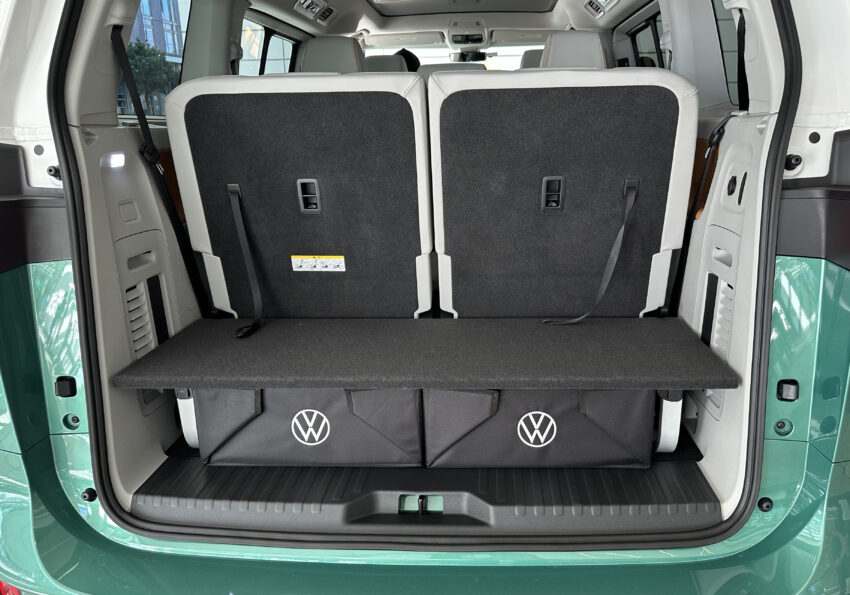
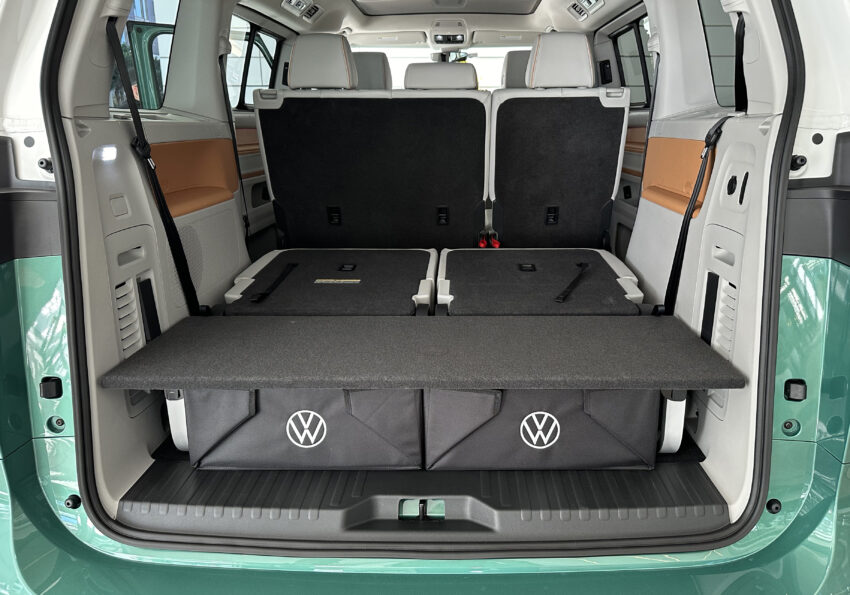
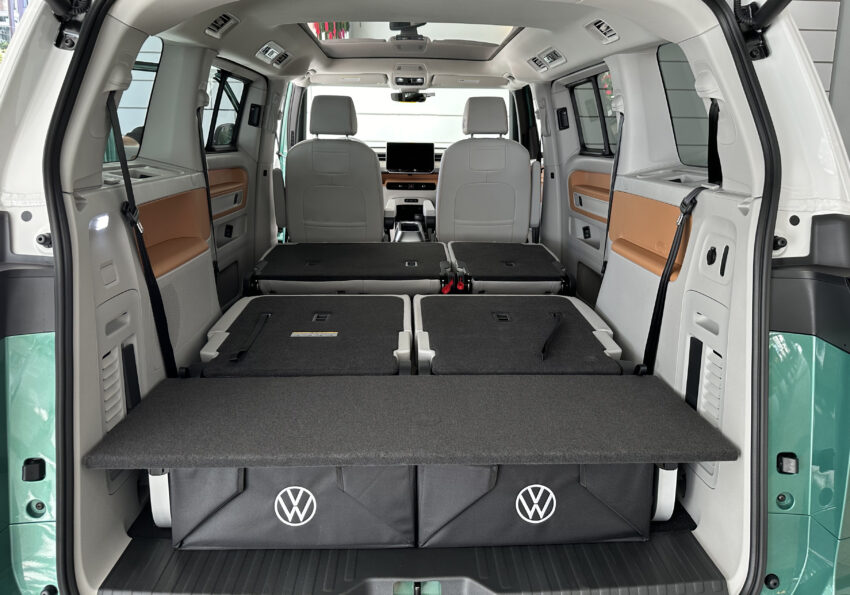
The Flexboard system (pictured above) that’s standard on the 1st Edition and optional on the Pro S Plus provides for a raised flat floor that’s level with the folded rear seat backs – almost a foot above the actual cargo bay floor. It can hold the weight of two adults. Campers will appreciate that when in use with the folded rear seats it creates a flat platform for a full-size mattress.
Rear-drive variants are rated for towing at up to 2,600 pounds and all-wheel drive versions can pull up to 3,500 lbs. Most competitors can do more and are clustered in the range of 3,500 to 5,000 pounds, with the Cadillac Escalade IQ leading the pack with an 8,000-pound maximum towing capacity.
Infotainment and Connectivity
VW has loaded most of the vehicle function controls into the 2025 ID.Buzz’s infotainment system, eliminating the need for most physical knobs and switches. We usually are put off by the complexity of such systems – diving four or five screens deep to change a setting is no fun – but the VW system in the Buzz is fairly straight forward and uncomplicated.
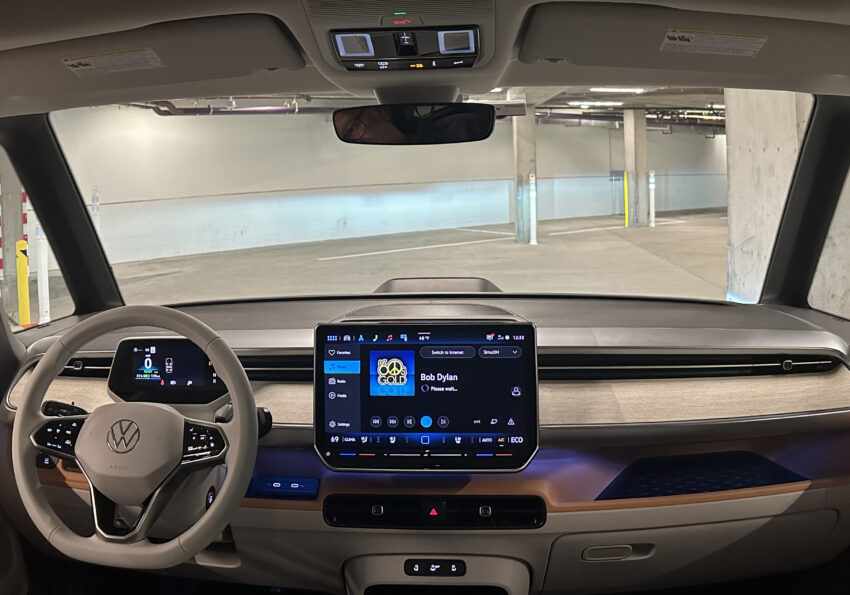
The command center is a 12.9-inch color touchscreen planted in the center of the dash.
In the “mine’s bigger than yours” sweepstakes, the Cadillac Escalade IQ wins with a nearly 30-inch combined driver info and infotainment screen (plus a 20-inch passenger-side infotainment screen), followed by the Tesla Model X with its 17-incher, the Rivian R1S’ 15.6-inch infotainment screen, the Volvo EX90’s 14.8-incher, and the Mercedes-Benz EQS SUV’s 12.8-inch screen (a 17.7-inch infotainment screen can be had on the Benz, but only as part of an optional 53-inch multi-screen panel).
The 2025 ID.Buzz will use the same upgraded infotainment system as the[Volkswagen ID.7 sedan, which was to have launched a few months earlier but now has been delayed in the U.S. until perhaps as late as the 2027 model year. The system has an improved voice command system that’s far more pleasant to use than the previous iteration. It also offers direct-access icons for the vehicle control functions and main screen, which helps limit the number of icons and menu pages a driver must access to set a new driving mode or change colors on the ambient lighting, for instance.
Climate system controls have been integrated into the bottom of the touchscreen, and the slide controllers for audio volume and cabin temperature are backlit so drivers can easily see them at night.
Wireless Apple CarPlay and Android Auto compatibility is standard, as are wireless phone charging, eight USB-C ports, and a 120-volt AC outlet located below the second-row seats. A Wi-Fi hot spot is available with a connected services subscription.
VW’s ID.Light signaling system also is standard. An LED light strip along the base of the windshield uses colors and light pulses to provide visual signals for a variety of things, including braking prompts, incoming phone call alerts, and, when plugged into a charging station, the battery’s charge levels.
Safety
The 2025 ID.Buzz has not been tested for crashworthiness by either the National Highway Traffic Safety Administration or the nonprofit Insurance Institute for Highway Safety.
Standard driver-assist and safety features forthe 2025 ID.Buzz include VW’s IQ Drive system for hands-on, Level 2 highway driving assistance. The package includes adaptive cruise control with full stop-and-go function, frontal-collision mitigation with pedestrian recognition, rear-collision migration, automatic emergency braking, lane-keeping and lane-centering assist, automatic high beams, and blind-spot monitoring with rear cross-traffic alert, and a driver awareness monitoring system.
Last Words
TheGreenCarGuy can be a sucker for stand-out design and utility in a vehlcle, and the 2025 ID.Buzz punches all the right buttons. But its $61K to $71K price range is a bit steep. We’ll have to hold out to see what the used market has to say in a few years. For some, the sub-250-mile range might also be an issue, but really, if the price is right, how many times a month do you drive more than 200 miles in a day? And won’t that gas-burner you still have stowed in the garage handle the occasional long trip if finding EV reliable chargers along the way is worrying you?
